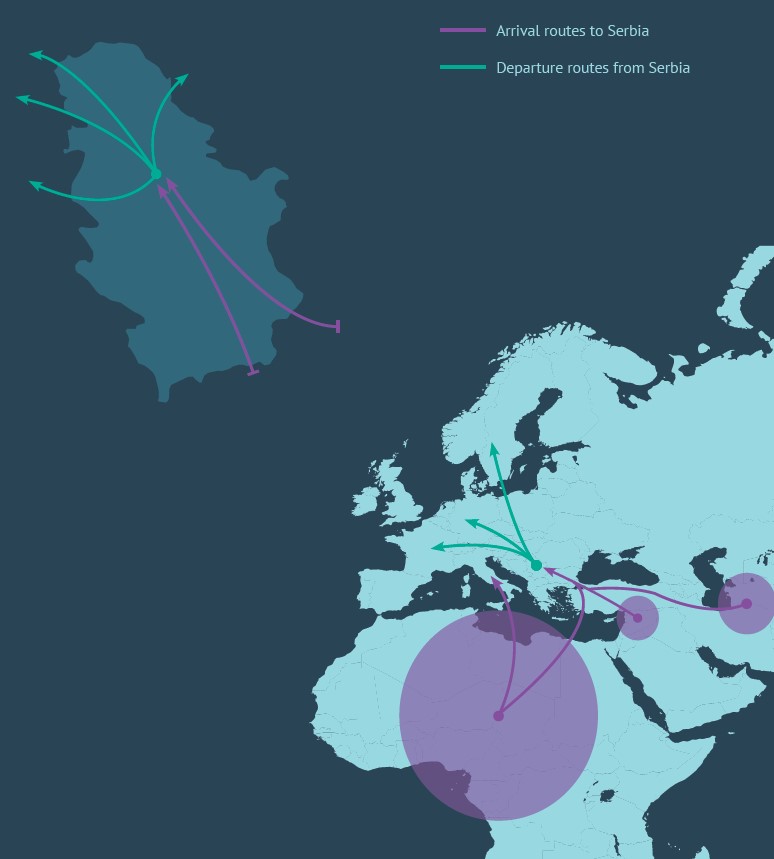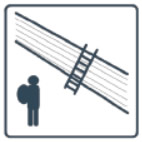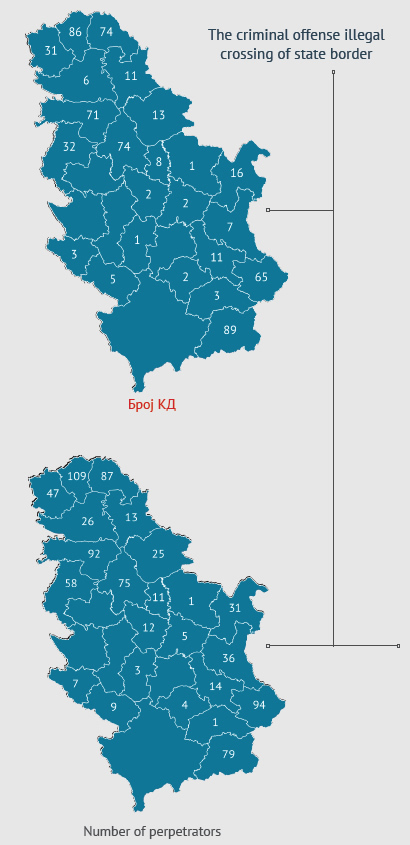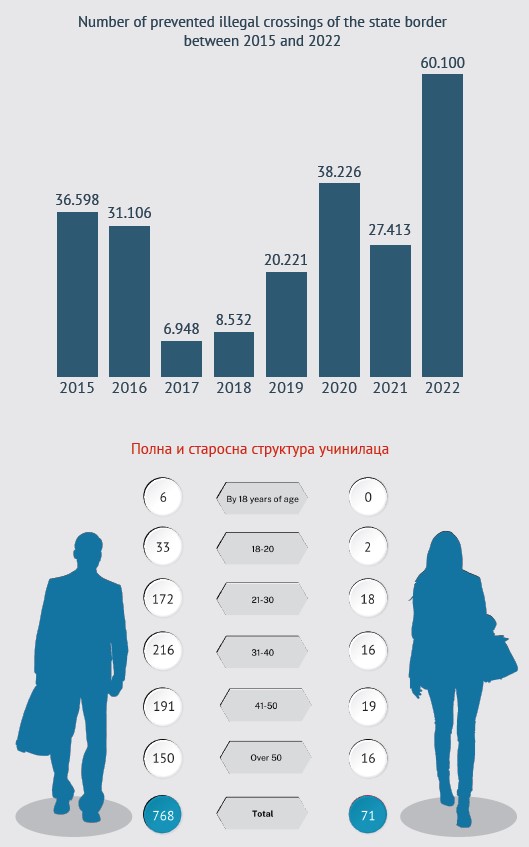Human smuggling
Human smuggling is a profit-driven criminal activity that is taking on a global character.
The situation in Serbia has not changed significantly since 2019. The majority is made up of irregular migrants who reach our country from Africa and Asia via Turkey, Greece, Bulgaria and North Macedonia, after which they are smuggled to Western European countries.
Global and Regional Nature of the Issue
Although human smuggling is the most topical issue in the territory of Europe, in the last decade this criminal activity has gained global proportions. Driven by financial motives and lenient sentencing policy, smugglers offer their services to socially or economically disadvantaged persons. Since human smuggling is one of the crimes that neither the perpetrator nor the irregular migrant have an interest in reporting, the dark figure is very large. Migrants are treated as a commodity, whose disappearance during transport is easily compensated.
According to UN estimates, through the two main smuggling routes – the first from East, North and West Africa to Europe, and the second from South America to North America – smugglers earn about 6.75 billion dollars a year.[1] Their proceeds are believed to be much higher on the global scale.
The number of illegal crossings of the external EU borders has been constantly increasing over the last four years. The Western Balkans represents the transit area through which migrants, starting from their home countries (Syria, Afghanistan, Pakistan, etc.) via Turkey towards Bulgaria or Greece, are trying to reach Western European countries. According to estimates, there are still more than five million refugees in Turkey. Their activities are then registered through Serbia, where sub-routes through North Macedonia and Bulgaria are joined, after which they continue towards the border with Hungary, Bosnia and Herzegovina, Croatia and Romania.
In the past few years, the EU has been particularly affected by migrations, caused by anti-COVID-19 measures, instrumentalization of migration by some countries and growing armed conflicts on the European continent, as a result of which the management of the migrant crisis has become a permanent feature of EU border management by the European Border and Coast Guard Agency (FRONTEX). The migrant route through the Western Balkans has been among the most frequently used routes for several consecutive years. In 2020, as a result of anti-COVID-19 measures, refugees and migrants faced increased difficulties and challenges in transit, at borders, in reception facilities and in destination countries.
Стање у Србији
Кријумчарење људи се у Србији није значајно променило у периоду од 2019. године до данас. Највише ирегуларних миграната и даље пристиже из афричких и азијских конфликтних зона и преко Турске, Грчке, Бугарске и Северне Македоније долази до Србије, одакле се даље кријумчаре у земље Западне Европе. Западнобалканска рута је, према подацима међународних институција, у том периоду добила епитет примарне. У Србији је након укидања ванредног стања и попуштања мера за спречавање ширења ковида 19 дошло до поновног јачања ирегуларних миграција, за разлику од других области криминала, које су током пандемије биле у стагнацији.
У периоду од 2019. до 2022. године спречено је укупно 145.960 незаконитих прелазака државне границе, што је за 75% више у односу на период од 2015. до 2018. године, када су спречена 83.184 преласка. Највећи број евидентиран је 2022. године 60.100, што представља 41% свих спречених незаконитих прелазака у четворогодишњем периоду. Тада је у Србији боравило више хиљада ирегуларних миграната, од којих је највећи број, укључујући и оне који су формално изразили намеру да траже азил, намеравао да нашу земљу користи само за транзит ка земљама Западне Европе.
У кријумчарење људи, укључена је мрежа национално повезаних криминалних група, које делују у земљама порекла, транзита и дестинације. Оне организују уплату новца и његову парцијалну исплату након остваривања контакта са појединцима и успешног транзита у наредним фазама кријумчарења. Новац се у највећем броју случајева не преноси физички, већ се уплате и исплате врше на хавала пунктовима дуж руте кријумчарења, или online у криптовалутама. Хаваладари су углавном угледни власници трговачких радњи или јувелирница, а често имају и улогу банкара које кријумчари користе за дистрибуцију акумулиране добити, као и за финансијске трансакције личне природе, невезано за процес кријумчарења.
У Србији су у кријумчарење људи укључени домаћи и страни држављани из мигранске популације. Држављани Србије најчешће се регрутују као возачи ирегуларних миграната и омогућавају њихов недозвољени транзит преко Србије ка некој од жаришних или излазних тачака.

Members of the migrant population, namely of Afghan, Pakistani, Moroccan or Syrian nationality, are the organizers of certain stages of smuggling, as well as guides and drivers. In all hotspots, in the territory of Pirot, Preševo, Belgrade, Sombor and Subotica, as well as at locations in or around the reception centers, one can recognize local service providers who establish contact between the arriving migrants and smugglers or taxi drivers.
As a special category made up of a smaller number of perpetrators from the migrant population, one can identify “promoters”, who act on behalf of the criminal group even outside the Serbian borders. Their main task is to promote the smuggling channel and videos from the destination countries on social media (TikTok, Telegram, Instagram and Facebook), through smart phones, as well as to obtain travel documents (forged or legitimate documents of somebody who resembles the potential user).
The most important security and financial link in the human smuggling chain are criminal group members in the border areas of Serbia and Hungary, where the border is relatively well protected and therefore riskier for crossing. Group members charge irregular migrants for safe passage, and in places from Kikinda through Horgoš and Subotica to Sombor, they are made up only of citizens of the countries from which the migrants originate. In this area, crossings are organized by mounting ladders on the wire fence used for reinforcing the border.
On the other hand, on entry points to Serbia from the direction of Bulgaria and North Macedonia, these groups are made up of a mixture of the local population (who know the ground and police movements) and citizens of the countries from which the migrants originate. Smuggling takes place between two border crossings (space unsuitable for physical and technical securing), using guides or navigation apps on smart phones.
From Serbia to Bosnia and Herzegovina, migrants are smuggled across the Drina river in small boats between Loznica and Zvornik.
In the immediate vicinity of illegal crossing points, frequently in an inaccessible area with small or tall vegetation, groups set up camps, where individuals perform security and reconnaissance tasks in fear of police and rival groups of smugglers. For this purpose, as well as for the purpose of gaining dominance in the territory where smuggling is organized, firearms are acquired and used, causing a number of recorded cases of injuring and killing of migrants by other migrants.
Within smuggling chains, a large number of Serbian citizens are also engaged in neighboring countries, facilitating the illegal transit of irregular migrants to the entry points into Serbia (from Bulgaria or Greece through North Macedonia) and from exit points from Serbia (in Hungary, Croatia, Romania and Bosnia and Herzegovina) to other destination countries within the EU (Austria, Germany, France, Belgium).
The following most frequently used methods for enabling direct illegal crossing of the state border in the period between 2019 and 2022 have been identified:

Smuggling across the "green line" using four ladders. The ladders are made of aluminum, are easy to carry and are set up quickly, which makes it possible to cross the wire fence within minutes. Irregular migrants, who usually arrive by taxi directly from the reception centers, are transferred in groups of at least ten, after which transportation already awaits them in the Hungarian territory. This is the most common method for crossing the border with Hungary and is mostly used by Syrian, Moroccan and Afghani groups of smugglers, who frequently exchange fire, fighting for territory.

Crossing at the border crossing, either by avoiding border control or by using forged documents, i.e. valid documents of other people who have similar features (“lookalike” documents). Documents are obtained in Greece, Bulgaria and Serbia or through social media channels which are made especially for this purpose (most frequently through the Telegram app). These are either original documents of Serbian citizens or forged or original documents of EU citizens.

Avoiding border control by hiding in passenger and freight vehicles, most frequently in specially built compartments in trailers. This is a frequent and particularly dangerous method of smuggling people, which in most cases puts their health and sometimes even their lives in danger. In some cases, groups of smugglers place smuggled persons in these spaces without the knowledge of the truck driver, most frequently in parking lots or rest areas near the state border.

Avoiding border control by hiding in freight train carriages, without the knowledge of train drivers, dispatchers and other employees in charge of transportation control and safety.

Smuggling across convenient parts of the Drina, Tisa and Danube rivers in small rubber boats with electric engines. Smugglers buy boats at shops, use their own or steal them.
In order to earn as much as possible, smugglers frequently transport too many irregular migrants. In one of the transports stopped in November 2022, members of an OCG (which was made up of 12 persons) transported 127 irregular migrants in a truck with a small trailer. Also in some cases, when stopped by the police, drivers jumped out of the vehicles and caused traffic accidents.
One of the most important factors in this area of crime are political developments in the countries of origin, transit and destination, including decisions on the visa regime and social policy in the destination countries. In addition to this, the strengthening of right-wing organizations throughout Europe and in Serbia creates a suitable ground for conflicts with migrants. Developments in the cities where irregular migrants are located, as well as in populated areas near the border lines aggravate the situation, because citizens become hostile towards migrants and expect the authorities to intensify the suppression of illegal migration.
The presence of smugglers on social media has become so indispensable that we have witnessed the so-called digitization of smuggling in recent years. Smugglers intensively use mobile apps for communication, especially encrypted communication, definition of geographic coordinates of migrants’ movements and payment for services, where online payments in cryptocurrencies have become more accessible and less risky.
Moreover, economic pressure and unequal access to legal migration routes can further encourage migrants to seek alternative ways of entering other countries, which increases the demand for smuggling services. In addition to this, conflicts around the globe, especially those in Syria as well as social changes in Afghanistan, directly spur migrations and result in an increase of the number of irregular migrants who strive to reach Western Europe, through Serbia as a transit area.
Climate changes in the migrants’ countries of origin, including those that cause natural disasters, droughts and floods, as well as significant losses in food production, have lately represented a particularly significant stimulating factor for migrations to countries where these changes are less prominent.
The lenient sentencing policy and the lack of organization in certain areas have encouraged many individuals and criminal groups to shift the focus of their activities from other forms of crime to human smuggling. An example of this policy is the April 2023 Hungarian government decree on reintegration detention, on the basis of which perpetrators of human smuggling crimes were deported to their countries of origin. They included several hundred Serbian citizens, which additionally increased recidivism in this area.
Between 2019 and 2022, police officers of the Ministry of Interior of the Republic of Serbia filed 597 criminal reports against 839 persons suspected of having committed the crime of illegal crossing of the state border and human smuggling. These reports included 23 criminal reports filed to the Public Prosecutor’s Office for Organized Crime against a total of 174 OCG members.
The aforementioned 597 criminal reports included more than 4,390 passive subjects (irregular migrants) who were enabled to illegally cross the state border, transit through Serbia or illegally stay in it.
In December 2022, an improvised camp was discovered in a forest near Subotica, where 22 migrants were hiding, including two members of the Afghan army – a general and a sniper from the Bardi 313 Taliban commando unit, ideologically linked to al-Qaeda – who had been wanted by France for the most serious crimes and terrorism. While the ground was searched during the operation, an automatic rifle with two magazines and ammunition was found.

In November 2022, in the territory of Požarevac, the arrest took place of three members of an organized crime group, which (in exchange for EUR 2,400 per migrant) had enabled dozens of Turkish citizens to enter Serbia (by obtaining letters of guarantee), to illegally cross the Serbian-Hungarian border, avoiding border control, and to transit further towards EU member states.

In December 2022, eight members of an organized crime group were arrested, which organized transit through Serbia and the crossing of the state border with Hungary, Croatia and Romania, as well as further transit to the Western European countries of 138 irregular migrants. Migrants were concealed in groups of 15 to 25 in specially built compartments in the cargo area of a truck, and the smuggling price was up to EUR 6,000 per person.

In an exchange of data between Serbia and Paraguay, it was revealed that in October 2020, in the port of Terpor in Paraguay, seven bodies had been found in a container with mineral fertilizer. Four of the deceased had Serbian reception center identification cards. In connection with this, one Moroccan and one Algerian citizens were arrested, because in late July 2020 they had taken EUR 500 per person to hide the migrants in the container and avoid detection by the Serbian and Croatian border control during smuggling.



Expected Future developments
► The political, security and economic situation in the migrants’ countries of origin will continue to be the main factor encouraging migrations (Syria, Afghanistan, Pakistan). In view of the inaccessibility of legal migration routes, we can expect that migrants will continue to move from Africa and Asia towards Turkey, and further via the Western Balkan route through Serbia to Western European countries.
► The visa policy and employment requirement liberalization policy, i.e. the need for workforce in EU member states, especially in Germany, as well as facilitation of requirements for family reunification, will additionally increase the motivation for illegal migrations. Due to its geographical position, Serbia will continue to be the most important transit country on the Western Balkan route, with possible occasional activation of sub-routes.
► The security situation with criminal migrant groups, especially their fight for territory and clashes with Hungarian authorities, will continue to cause dissatisfaction and conflicts among migrants themselves, as well as the use of physical violence, cold weapons and firearms, which might increase along the border with Bulgaria and towards the Serbian security authorities.
► Conflicts among migrants of different nationalities and unstable proceeds from smuggling will continue to result in occasional kidnappings near state borders, reception centers and hotspots.
► The risk of the infiltration of terrorist group members in the migrant population will continue to exist, with the possibility of establishment of new smuggling groups, especially near the border with Hungary.
► Although the percentage of children and women in the migrant population has reduced, this vulnerable category is still exposed to risks, especially from physical and psychological abuse and from becoming victims of human trafficking.
► The hawala money transfer system will remain dominant, but the advantages of cryptocurrencies will contribute to their greater use in different stages of smuggling.


